
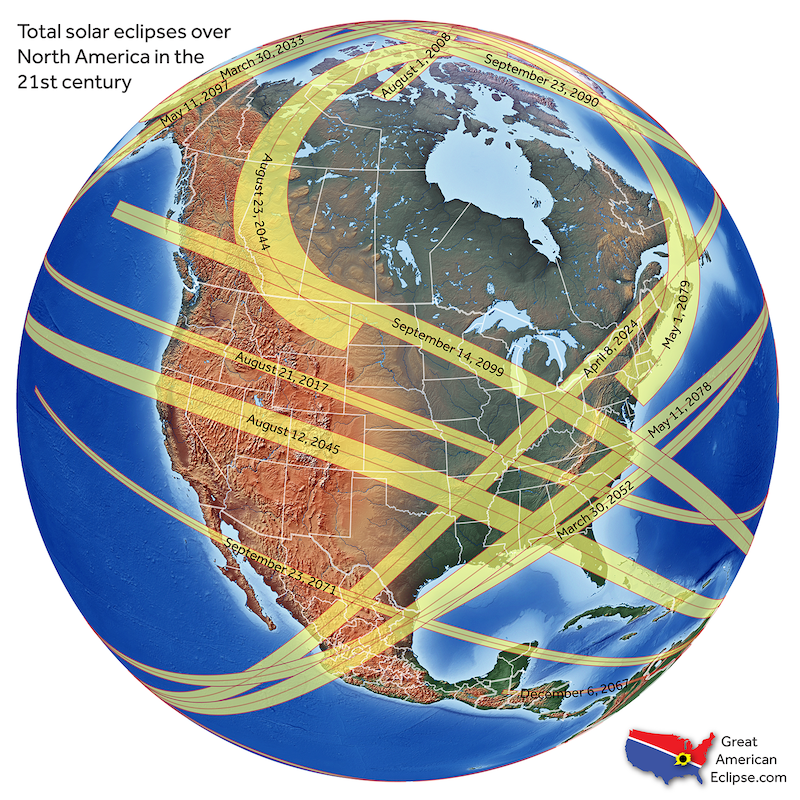
See larger | After the total solar eclipse of August 21, 2017, the next total solar eclipse to cross the North American continent will be on April 8, 2024. This image shows all total solar eclipses of the 21st century over North America. Image via GreatAmericanEclipse.com
Check out the map above. It shows all the total solar eclipses taking place in North America during the 21st century. You can see that the next total eclipse for North America will occur on April 8, 2024.
This might make it seem as if eclipses are somewhat rare, when, in fact, they’re not. They happen about every 18 months as seen from somewhere in the world. However, for any given spot on Earth’s surface, total solar eclipses don’t happen very often, if even within a person’s lifetime. The fact is, you might have to travel to see an eclipse.
The next total solar eclipse will cover three countries, including 11 U.S. states and five Canadian provinces (if you count the northwestern tip of Nova Scotia). It will start in Mexico, travel across Texas, and then continue north-north-east, taking turns between the U.S. and Canada in the northeast before it exits the continent over Newfoundland. If the weather is benign, this promises to be an even better eclipse – in terms of length of totality (the time the sun is covered) – because the path of totality will be wider than that of the eclipse of 2017.
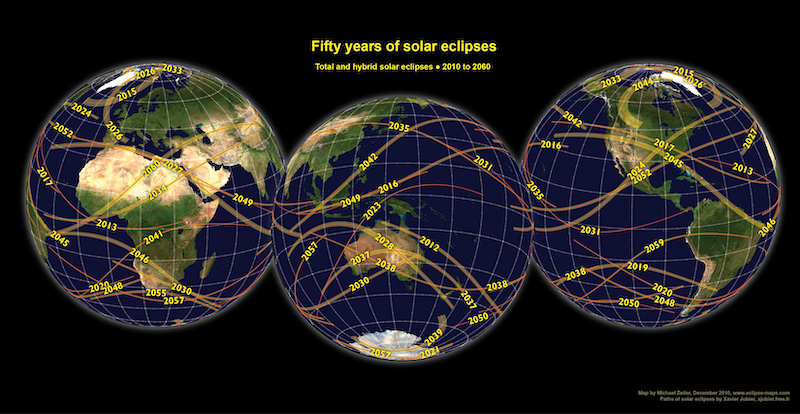
See larger. | Solar eclipses taking place across the world from 2010 to 2060. Here, annular and hybrid eclipses are also included. Image via Michael Zeiler/ Xavier Jubier.
In addition to total eclipses, there are other sorts of solar eclipses. There are partial solar eclipses, where only a part of the sun is covered, and annular solar eclipses, where the moon is a bit further away from us in its orbit and consequently appears too small to cover the sun completely. In an annular eclipse, the sun appears in a ring or annulus around the moon; that’s why these sorts of eclipses are also known as ring eclipses. There are also hybrid eclipses, that look like a total or an annular eclipse, depending on the location of the observer. Then, of course, there are eclipses of the moon. One or another of these different eclipses is likely to occur in a location near you, within not too long of a time span!
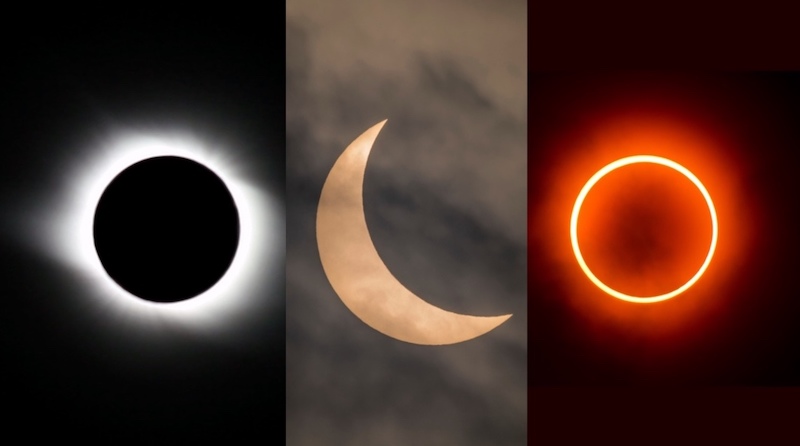
The appearance of a total, partial and annular solar eclipse. Image via K. Bikos/ Timeanddate.com.
Once you have seen one total solar eclipse, it’s not unlikely you’ll want to catch another. There were two opportunities recently, both in South America, on July 2, 2019 and December 14, 2020. The Covid-19 pandemic probably thwarted many a travel plan for the latter one. But there will be more! Below is a map from Michael Zeiler’s eclipse-maps.com, which can act as a travel planner for the keen eclipse chaser.
Look here for a complete list of solar eclipses between the years 2015-2030.
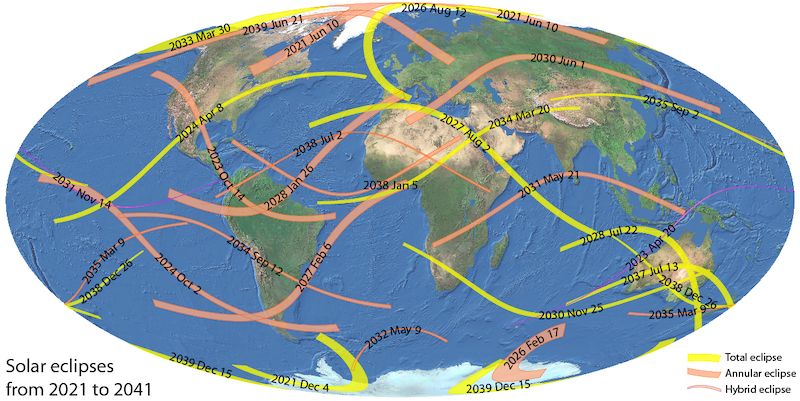
Travel atlas for the eclipse chaser: here are the solar eclipses over the world for 2021-2041. Yellow lines refer to total eclipses while orange ones are annular and purple are hybrid eclipses. See this and many more maps here. Image via Michael Zeiler/ Xavier Jubier.
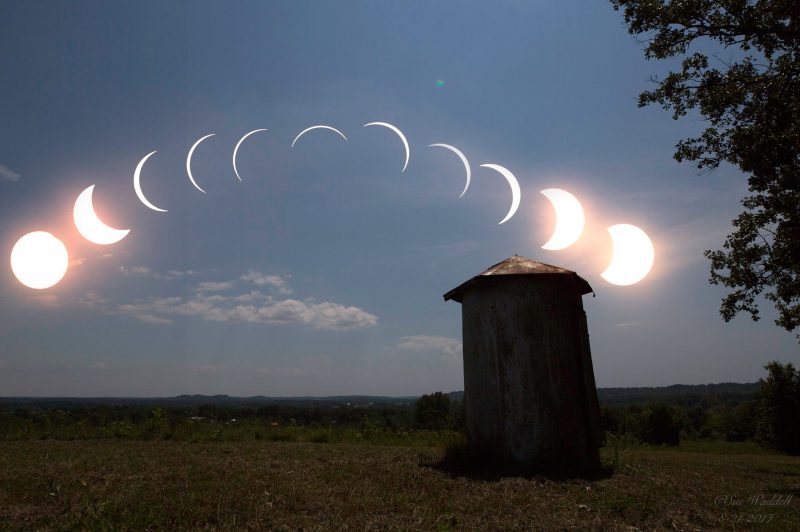
Sue Waddell contributed this eclipse composite from Eastview, Kentucky, on August 21, 2017, where there was a 98.3 percent eclipse. See more photos of the August 21 eclipse.
Bottom line: The next total solar eclipse visible from North America will be on April 8, 2024.
Photos of the August 21, 2017, eclipse here
How ISS astronauts saw the August 21, 2017 eclipse
Read more: Are lunar eclipses more common than solar eclipses?
from EarthSky https://ift.tt/3l0Eg65


See larger | After the total solar eclipse of August 21, 2017, the next total solar eclipse to cross the North American continent will be on April 8, 2024. This image shows all total solar eclipses of the 21st century over North America. Image via GreatAmericanEclipse.com
Check out the map above. It shows all the total solar eclipses taking place in North America during the 21st century. You can see that the next total eclipse for North America will occur on April 8, 2024.
This might make it seem as if eclipses are somewhat rare, when, in fact, they’re not. They happen about every 18 months as seen from somewhere in the world. However, for any given spot on Earth’s surface, total solar eclipses don’t happen very often, if even within a person’s lifetime. The fact is, you might have to travel to see an eclipse.
The next total solar eclipse will cover three countries, including 11 U.S. states and five Canadian provinces (if you count the northwestern tip of Nova Scotia). It will start in Mexico, travel across Texas, and then continue north-north-east, taking turns between the U.S. and Canada in the northeast before it exits the continent over Newfoundland. If the weather is benign, this promises to be an even better eclipse – in terms of length of totality (the time the sun is covered) – because the path of totality will be wider than that of the eclipse of 2017.

See larger. | Solar eclipses taking place across the world from 2010 to 2060. Here, annular and hybrid eclipses are also included. Image via Michael Zeiler/ Xavier Jubier.
In addition to total eclipses, there are other sorts of solar eclipses. There are partial solar eclipses, where only a part of the sun is covered, and annular solar eclipses, where the moon is a bit further away from us in its orbit and consequently appears too small to cover the sun completely. In an annular eclipse, the sun appears in a ring or annulus around the moon; that’s why these sorts of eclipses are also known as ring eclipses. There are also hybrid eclipses, that look like a total or an annular eclipse, depending on the location of the observer. Then, of course, there are eclipses of the moon. One or another of these different eclipses is likely to occur in a location near you, within not too long of a time span!

The appearance of a total, partial and annular solar eclipse. Image via K. Bikos/ Timeanddate.com.
Once you have seen one total solar eclipse, it’s not unlikely you’ll want to catch another. There were two opportunities recently, both in South America, on July 2, 2019 and December 14, 2020. The Covid-19 pandemic probably thwarted many a travel plan for the latter one. But there will be more! Below is a map from Michael Zeiler’s eclipse-maps.com, which can act as a travel planner for the keen eclipse chaser.
Look here for a complete list of solar eclipses between the years 2015-2030.

Travel atlas for the eclipse chaser: here are the solar eclipses over the world for 2021-2041. Yellow lines refer to total eclipses while orange ones are annular and purple are hybrid eclipses. See this and many more maps here. Image via Michael Zeiler/ Xavier Jubier.

Sue Waddell contributed this eclipse composite from Eastview, Kentucky, on August 21, 2017, where there was a 98.3 percent eclipse. See more photos of the August 21 eclipse.
Bottom line: The next total solar eclipse visible from North America will be on April 8, 2024.
Photos of the August 21, 2017, eclipse here
How ISS astronauts saw the August 21, 2017 eclipse
Read more: Are lunar eclipses more common than solar eclipses?
from EarthSky https://ift.tt/3l0Eg65

Aucun commentaire:
Enregistrer un commentaire